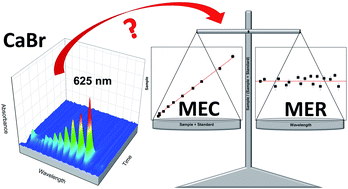Introducing multi-energy ratios as an alternative to multi-energy calibration for Br determination via high-resolution continuum source graphite furnace molecular absorption spectrometry. A case study†
Abstract
This manuscript explores the advantages of using multi-signal calibration approaches for the determination of non-metals via high-resolution continuum source graphite furnace molecular absorption spectrometry (HR CS GFMAS), targeting Br as an example. Besides multi-energy calibration (MEC), a novel approach deriving from it, multi-energy ratios (MER), is introduced and compared under different conditions. This approach makes use of the same data but in a different way, such that no linear regression is performed; instead, ratios are calculated. This article investigates the potential errors deriving from the use of amounts of spike dissimilar from the sample content, leading to too high (close to 1) or too low (close to 0) slopes/ratios, setting the best conditions in terms of precision and accuracy for the intended determination in the range of approx. 0.5 to 0.6. Also, situations where the use of MER could be recommended over MEC are identified: namely when only a few transitions of sufficient sensitivity and free from overlaps are available or else, many transitions but of similar sensitivity, which may occur when HR CS GFMAS is deployed. Otherwise, for multiple transitions covering a wider sensitivity range, use of linear regression and thus, of MEC, seems favoured, as a better precision can be achieved. The calculation of limits of detection and quantification for both approaches is also discussed. It is finally further demonstrated that these multi-signal strategies help in solving chemical interferences, which very often hamper the determination of non-metals with HR CS GFMAS, and they do so in a simple way, without the need for laborious work or for the preparation of several standards and sample aliquots, therefore making them a very intriguing option when this technique is deployed.



 Please wait while we load your content...
Please wait while we load your content...